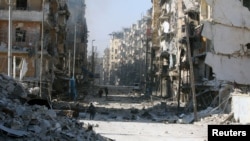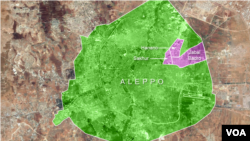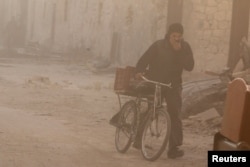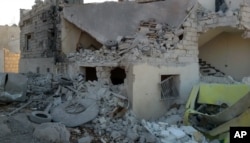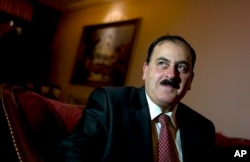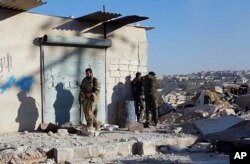The much fought over front lines in Aleppo separating Syrian rebels in the eastern districts from the mixed forces of President Bashar al-Assad surrounding them have begun to shift dramatically — that’s hardly surprising given how outmatched the fight has become both in terms of manpower and the massive air power that’s being brought to bear on insurgents and civilians alike in the east.
The anti-Assad rebel pocket in the east has now been split into two after regime forces captured the district of Sakhour, according to independent monitors as well as Syrian government officials. Syrian regime units have also pushed deep inside the strategic Hanano District in the rebels’ eastern pocket and they launched a fierce assault on another key district, ’Ard Al-Hamra.
Rami Abdulrahman, director of the U.K.-based Syrian Observatory for Human Rights, which relies on a network of monitors on the ground, estimates that opposition militias have lost more than third of the area they controlled in Aleppo city since the regime renewed an offensive in September.
That land-grab owes much to Russian intervention. According to Nawar Oliver of the Omran Center for Strategic Studies, an Istanbul-based think tank, Russian warplanes have mounted 3,359 airstrikes on Aleppo province in the past three months.
Oliver says only one percent targeted the Islamic State terror group — the rest hit anti-Assad rebels and civilians mostly in the city’s eastern and southern districts, or to the west or south of the city where insurgents have tried at various times to break a months-long siege of their districts.
However, the ground being taken by Assad’s forces with Shi’ite militias from Iraq, Lebanon and Iran largely in the vanguard is being gained painstakingly slowly. Each collapsed house and rubble-strewn street is being fought over time and again. The assault on eastern Aleppo is taking its toll of government forces.
Last week. the head of a foundation in Tehran that provides aid to the families of the dead admitted that more than a thousand fighters with Iranian militias, many of them Afghan Shi’ite exiles, have been killed in combat in Syria — about 400 appear to have died fighting in Aleppo province in just the past three months.
For the rebels, bravado goes hand-in-hand with the desperate resistance the insurgents have mounted since a Russian-backed offensive in February across northern Syria left eastern Aleppo encircled. The commanders of the estimated 8,000 rebels drawn from Free Syrian Army and Islamist militias and the al Qaida-linked Jabhat Fateh al-Sham insist they can continue to fend off Assad’s forces. But when asked how, they fall back on citing the fighting spirit of the rebels — hardly a strategy to counter overwhelming numbers, the advantage of airpower and more powerful weaponry
The rebels have mounted major counter-attacks in recent weeks as they have battled to hold on to districts that first fell to them four years ago. But each rebel counter-offensive has been rolled back — the last concerted one in mid-November ended in failure when regime forces recaptured two districts on the southwestern outskirts of the city.
That has left the insurgents to resort themselves to indiscriminate shelling of parts of western Aleppo, a propaganda boon for a regime that’s under fierce international condemnation for its massive targeting of hospitals, makeshift clinics, markets and schools. The White Helmets, a first-responders group, warned last week the meager food stocks left will run out within the next few days.
The huge Assad assault — regime reinforcements were sent to the city this weekend in what Damascus calls a “decisive final battle” — is testing not only the endurance of an estimated quarter-of-a-million civilians trapped, bombed on and starving in the eastern pocket.
It is testing the rebel forces — to the breaking point, fear diplomats, analysts and some rebel leaders.
“Can they hold out? No, sadly no, from a military point of view, of course, they can’t,” says Gen. Salim Idris, a former commander-in-chief of the Free Syrian Army. “It is hell in there,” he adds.
Western diplomats also tell VOA that unless there’s a change of heart by the West and a supply of anti-aircraft missiles to the insurgents, it is only matter of time, possibly just weeks, before there’s a rebel collapse in eastern Aleppo.
“Assad and the Russians mean to finish the rebels in Aleppo and with the indiscriminate, relentless bombardment I can see no way that isn’t going to happen,” says a Turkey-based Western diplomat, who asked not to be identified for this article.
“They have to fold, unfortunately.” he added.
Despite Assad regime claims that civilians are being prevented from leaving the east by the rebels, most residents contacted by VOA say they are more fearful of an insurgent collapse in their neighborhoods. “Assad’s people are not going to treat us kindly if they break through — that’s clear from their bombing of us now,” says Mohammed, a onetime shop-owner and father of three, who like all civilians in the east forages as best he can for food to feed his family.
“We have mainly been surviving on rice,” he said. “I managed to grow some food on the roof of the house but not enough to help us through the winter months,” he adds. “But then maybe this is all over before the winter comes,” he said.
A Syrian obstetrician spoke of her fears to CNN last week. After explaining how she helped a wounded mother birth a baby whose eyes had been damaged from shrapnel injuries to the mother’s back and abdomen, she said: “I am so afraid the rebels will surrender.”
And there seems little hope that Turkish-backed rebels fighting northeast of Aleppo against Kurdish militias and the Islamic State will be able to assist their comrades in the city.
Turkey’s Prime Minister, Binali Yıldırım, appears to be eager to assuage Damascus fears that the Turkish military intervention will somehow get entangled in Aleppo. The Turks’ Euphrates Shield operation in northern Syria will not target Aleppo, he told TRT television in an interview. “We don’t have such a target,” he said, walking back his midweek threat of retaliation against Damascus for what Turkey claimed was a Syrian airstrike in northern Syria that killed four Turkish soldiers.
If the rebels fold in eastern Aleppo, beaten into defeat by overwhelming numbers and scorched-earth airstrikes, what then?
“It is very dangerous if they lose Aleppo — the Assad forces will then focus west on Idlib province and then that will be the end,” laments Gen. Idris. “Homs, Hama, they are over. In the south nothing is happening. The commanders down there tell me the situation is very bad. They lack ammunition and outside support and all they can do is just hang on. The Damascus suburbs are desperate, too, for the militias,” he adds.
Russian warplanes have already started pummeling Idlib. In mid-November, Russian Minister of Defense Sergey Shoygu announced the start of a “major operation” that he said would target ISIS and al-Qaida in Idlib. But as with Aleppo, the FSA and Islamist militias are bearing much of the brunt of airstrikes including from sorties flown by Su-33 ‘Flanker-D’ fighters launched from the the Russian aircraft carrier ‘Admiral Kuznetsov’ in the Eastern Mediterranean.
“Idlib will become the next killing ground,” says a Western diplomat. “And that will in effect kill what is left of the Syrian revolution,” he adds.




